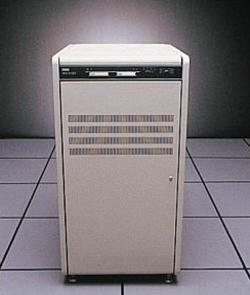 |
1982 |
 |
The VAX-11/730 was aimed at
small companies, offices. In those days, such a small multiuser VMS-configuration
was considered as a small miracle, even if it was slow (0.3 VUP)! The CPU
was implemented on three hex-size PCB boards, using AM2900-series bit-slice
processors. The base configuration also included an internal disk controller
(IDC) to deal with RL02 and R80 disk drives, and the expansion bus was
Unibus (as normal). The chassis incorporated two TU58 tape drives, the
CPU microcode was loaded off these - without the console tapes the machine
is pretty useless.
The system was normally packed into a small rack together with two disk drives, the photo to the left depicts a rather rare version. |
Misc
ALL-in-1: Integrated office suite with networking support. It incorporated a word processor, a calendar and a mail client.
RA60 és RA81: The RA60 was a 205MB removable disk pack drive, while the RA81 was a 456MB 14" winchester drive. Both used the DEC-specific SDI protocol; their typical controller was the UDA50 on the Unibus (And later KDA50 on the Qbus, KDB50 on the BI-bus, KDM70 on the XMI bus), or they could have been used on HSC's in VAX clusters.
The Digital almost-PC triumvirate: The PC business just began to boom, and Digital wanted to be part of that. They didn't take the IBM-compatible road, and introduced three small computers based on successful architectures. One of them was the PDP-11-based Professional 300, the second was the PDP-8-based DECmate II, and the third was the Rainbow, which used both an i8088 and a Z80 processor. All three were nicely engineered machines, but failed commercially.

